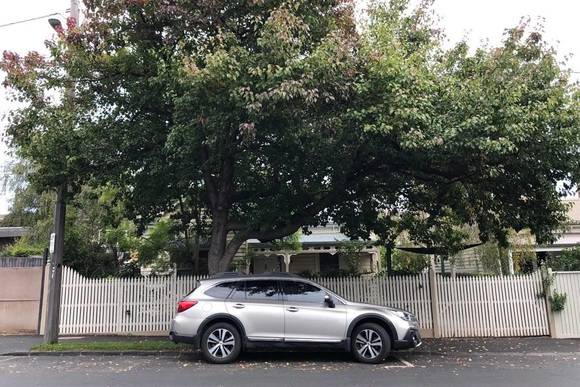| Back to search results » | Back to search page » |
|
26 Royal Crescent, ARMADALE
Location26 Royal Crescent, ARMADALE VIC 3143 - Property No 36233 LevelIncl in HO area Significant |
|
Statement of Significance
Part of the Armadale Precinct
What is significant?
Constructed on land purchased at the Crown Land sales of May 1850,
the Armadale Precinct developed as part of the broad surge of
development through Prahran, Malvern and the inner suburbs more
generally through the 1880s. The earliest development dates from the
1860s and 1870s and a number of key buildings from this period
survive. The construction of the railway through Armadale to Oakley
disrupted the original subdivision to create an irregular group of
streets, subsequently developed with polite villas and cottages
through the 1880s and with more substantial dwellings through the
early twentieth century to produce a handsome and expansive suburban
environment. The Toorak Railway Station, which stimulated development
of the area and the retail group in Beatty Avenue, constructed to
service it, are significant elements. The flats Clendon and Clendon
Corner are not typical of built form in the area but are important
buildings in their own rights. Elements which contribute to the significance of the precinct vary
from street to street but include: . The high degree of intactness of the area to its c1930 state
arising from the low proportion of later infill; . The intactness of individual buildings to their original states.
Dwellings typically survive with their presentation to the street
largely unaltered retaining facades, verandahs and decorative
detailing intact; . The consistent single-storey height and modest scale of the
residential built form; largely derived from the prevalence of the
freestanding single-storey villas and modest semi-detached pairs on
generous allotments. . The consistent face brick, timber or render materiality and gabled
or hipped roofscapes with chimneys and roofs in slate or terracotta tiles; . The landscaped character of the area arising from mature street
plantings in conjunction with open, landscaped front and side setbacks
to individual properties; . Low and permeable front fences in most sections of the precinct; . Road alignments and allotment patterns resulting from nineteenth
and early twentieth century subdivisions; . The general absence of vehicle accommodation in front setbacks,
particularly in some areas to the east of the Armadale Primary School
such as Glassford Street and in more modest streets such as Watson and
Eileen Streets; . The Railway Station and shops in Beatty Avenue and their
relationship to nearby residential stock. . Early stables to the rear of dwellings at 28 Northcote Road and 64
Rose Street. . Mid-twentieth century flats,ClendonandClendon
Cornerin Clendon Road are atypical elements within this precinct
but remain significant buildings in their own rights.
How is it significant?
The Armadale Precinct, Armadale is of local, social, historical and
aesthetic significance.
Why is it significant?
The Armadale Precinct is aesthetically significant as an unusual
surviving urban landscape. It is architecturally significant as an
intact collection of late nineteenth and early twentieth century
buildings. Buildings adopt a range of architectural expressions at a
variety of scales ranging from cottages or other modest forms of
housing on small blocks to polite suburban villas to very grand
buildings such as the station and retail groups in Beatty Avenue. A
small number of, primarily Edwardian, dwellings are of a scale and
architectural distinction usually associated with Mansions. The area
is highly intact to its c.1930 state with few modern interventions and
the greater part of its building stock demonstrates a high level of
integrity to its original form. Areas of this intactness and integrity
are becoming increasingly rare. The Armadale Precinct is of historical significance for the manner in
which it illustrates the early development of the Municipality. It
retains associations with Landboomer, and later Premier, James Munro
and with local developers such as Robert Sutherland and Michael
Glassford(3.3.3 Speculators and Landboomers). The area
developed in two distinct and legible phases which allow the boom of
the 1880s (8.2.1Middle-class suburbs and the suburban ideal)
the recession of the early 1890s and the recovery in the early
twentieth century (3.3.5 Recovery and
infill 1900-1940) to be understood. In addition, its varied
street layouts and relationship with the railway illustrates thead
hocnature of nineteenth century planning (3.3.4 Uncontrolled
and unplanned development). The area survives as a snapshot of
local development to c.1930. The Armadale Precinct is of social significance for the extent to
which it illustrates the introduction of new subdivisional typologies
which added to the range of choices for family living. The development
of suburbs around transport nodes (8.2.1Middle-class suburbs and
the suburban ideal)fundamentally altered living and working
patterns. The Railway Station in Beatty Avenue (4.4.2.Developing
state railway systems in the late nineteenth century) and the
local shopping strip (7.1 Serving local communities) were
essential to this new form of habitation.
Group
Residential buildings (private)
Category
House




